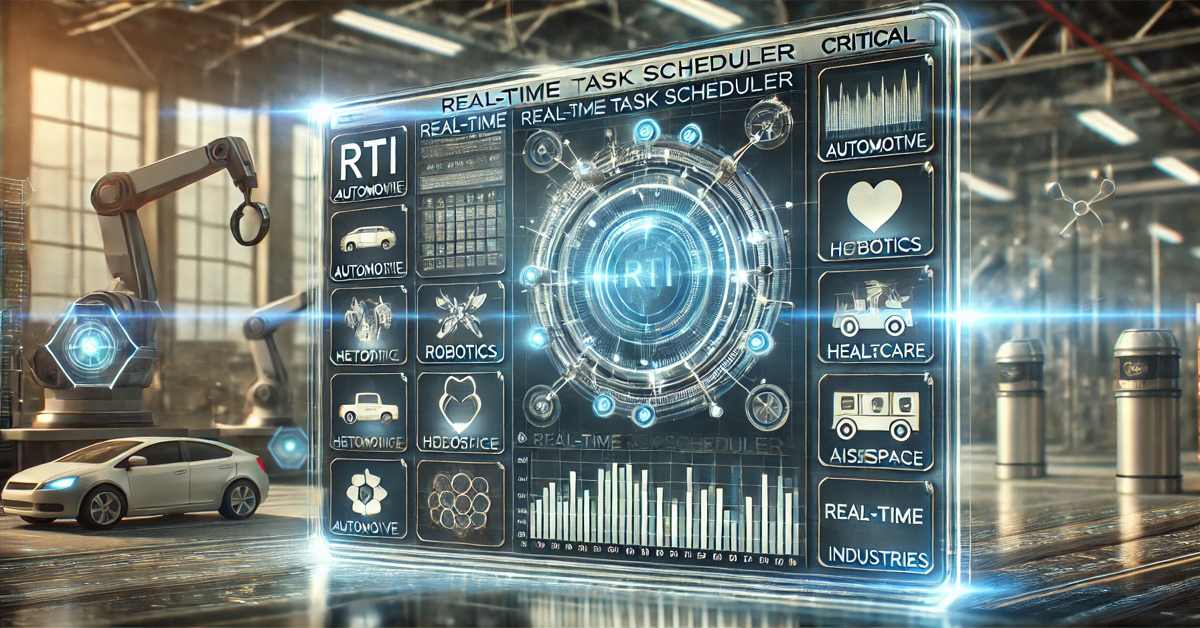In the modern digital era, the importance of real-time task scheduling cannot be overstated. With industries like automotive, aerospace, robotics, and telecommunications relying heavily on precise execution of tasks, the RTI (Real-Time Infrastructure) Scheduler has emerged as a cornerstone technology. This article explores the RTI Scheduler, its working principles, use cases, benefits, and implementation strategies. By the end, readers will gain an in-depth understanding of why this tool is integral in today’s high-performance systems.
Understanding Real-Time Scheduling
Real-time scheduling involves managing tasks that must be executed within strict time constraints to ensure system stability and efficiency. Unlike traditional scheduling methods, where delays are tolerable, real-time systems demand predictability and precision. These systems are classified into two types:
- Hard Real-Time Systems: Missing deadlines can lead to catastrophic failures, such as in aerospace control or medical equipment.
- Soft Real-Time Systems: Deadline misses result in degraded performance but do not cause critical failures, such as in multimedia streaming.
The RTI Scheduler is a specialized component within these systems that ensures tasks are executed as per their time-critical requirements.
What Is an RTI Scheduler?
The RTI Scheduler is a software or hardware tool designed to manage the scheduling of real-time tasks in an embedded system or operating environment. It enables developers to:
- Define tasks with specific time constraints.
- Allocate resources efficiently.
- Ensure predictable execution within the constraints of the system.
An RTI Scheduler works on algorithms that prioritize tasks based on factors such as deadlines, criticality, and resource availability. By adhering to these priorities, the scheduler ensures seamless operation in systems that demand precision.
Core Principles of RTI Scheduling
RTI scheduling revolves around several principles to achieve its objectives:
- Task Prioritization: Tasks are assigned priorities based on their urgency and importance. High-priority tasks preempt lower-priority ones to ensure timely execution.
- Determinism: The scheduler must guarantee predictable behavior, ensuring that tasks execute within predefined time windows.
- Resource Allocation: Efficient allocation of CPU, memory, and I/O resources is crucial to prevent bottlenecks.
- Concurrency Management: RTI Schedulers enable the simultaneous execution of tasks while avoiding conflicts through synchronization mechanisms.
- Latency Minimization: The scheduler reduces delays between task activation and execution, ensuring responsiveness.
Key Components of an RTI Scheduler
1. Task Queue
The task queue holds tasks waiting to be executed. Tasks are organized based on their priority levels.
2. Dispatcher
The dispatcher assigns tasks from the queue to the processor. It ensures tasks are executed in the correct sequence.
3. Timing Mechanisms
Timing mechanisms, such as clocks and timers, monitor task deadlines and trigger executions accordingly.
4. Interrupt Handlers
These handle asynchronous events that require immediate attention, ensuring the system remains responsive.
5. Resource Manager
The resource manager oversees the allocation of system resources to avoid contention.
Scheduling Algorithms
The RTI Scheduler employs various algorithms, each suited to specific use cases:
- Rate-Monotonic Scheduling (RMS): A fixed-priority algorithm where tasks with shorter periods are given higher priorities.
- Earliest Deadline First (EDF): A dynamic-priority algorithm that prioritizes tasks based on their impending deadlines.
- Least Laxity First (LLF): Tasks are scheduled based on the slack time (difference between deadline and remaining execution time).
- Priority Inheritance Protocol: Prevents priority inversion by temporarily boosting the priority of lower-priority tasks that block higher-priority tasks.
- Cyclic Scheduling: Executes tasks in a predefined cyclic order, suitable for systems with periodic tasks.
Applications of RTI Schedulers
1. Automotive Systems
RTI Schedulers are vital in managing real-time tasks in Advanced Driver Assistance Systems (ADAS), engine control units, and infotainment systems.
2. Aerospace
Flight control systems and navigation rely on RTI Schedulers for precise operations under stringent timing constraints.
3. Robotics
Industrial robots use RTI Schedulers to coordinate movements, ensuring precision and efficiency.
4. Healthcare
Medical devices like ventilators and monitoring systems use RTI Schedulers to deliver real-time responses critical to patient care.
5. Telecommunications
Network switches and routers utilize RTI Schedulers to manage data packets in real-time, ensuring seamless communication.
Advantages of RTI Schedulers
1. Enhanced Reliability
Predictable task execution minimizes the risk of system failures, making RTI Schedulers essential in critical systems.
2. Optimized Resource Usage
By managing resources efficiently, RTI Schedulers enhance overall system performance.
3. Scalability
RTI Schedulers can accommodate growing system complexities by adapting task priorities and execution patterns.
4. Real-Time Insights
Monitoring and logging capabilities provide valuable insights into system performance and task execution.
5. Reduced Latency
RTI Schedulers minimize response times, ensuring systems remain highly responsive.
Challenges in Implementing RTI Schedulers
1. Complexity
Designing and implementing RTI Schedulers requires a deep understanding of real-time systems and their constraints.
2. Resource Contention
Managing resource conflicts, especially in systems with limited resources, is a significant challenge.
3. Testing and Validation
Ensuring the scheduler meets real-time requirements demands rigorous testing and validation.
4. Overhead
Scheduling overhead can impact system performance, necessitating efficient algorithms and implementations.
5. Integration Issues
Integrating RTI Schedulers into existing systems can be challenging, especially when dealing with legacy hardware or software.
Best Practices for RTI Scheduler Implementation
- Understand System Requirements: Analyze task characteristics, resource constraints, and timing requirements before designing the scheduler.
- Choose the Right Algorithm: Select a scheduling algorithm that aligns with the system’s needs and task patterns.
- Prioritize Testing: Use simulation and real-world testing to validate the scheduler’s performance under various conditions.
- Optimize Resource Usage: Implement mechanisms to prevent resource contention and ensure efficient utilization.
- Leverage Tools: Use specialized software tools and frameworks to simplify scheduler development and debugging.
Future of RTI Scheduling
As systems become increasingly complex, the demand for advanced RTI Scheduling solutions will grow. Innovations such as AI-driven scheduling, adaptive algorithms, and integration with edge computing are shaping the future. These advancements promise to make real-time systems more efficient, reliable, and scalable.
Conclusion
The RTI Scheduler is an indispensable component of real-time systems, ensuring tasks are executed predictably and efficiently. Its applications span a wide range of industries, from automotive to healthcare, highlighting its versatility and importance. By understanding its principles, components, and best practices, developers can harness the power of RTI Scheduling to build robust systems capable of meeting the demands of the modern world.
FAQs
1. What is the primary function of an RTI Scheduler?
The primary function of an RTI Scheduler is to manage the execution of real-time tasks within a system, ensuring they are completed within predefined time constraints.
2. How does an RTI Scheduler differ from traditional task schedulers?
Unlike traditional task schedulers, RTI Schedulers focus on strict timing constraints and predictability, ensuring tasks execute at specific intervals or deadlines.
3. What are the most common algorithms used in RTI Scheduling?
Common algorithms include Rate-Monotonic Scheduling (RMS), Earliest Deadline First (EDF), and Least Laxity First (LLF).
4. In which industries are RTI Schedulers most commonly used?
RTI Schedulers are widely used in automotive, aerospace, robotics, healthcare, and telecommunications industries.
5. What are the main challenges in implementing an RTI Scheduler?
Challenges include managing resource contention, minimizing scheduling overhead, and ensuring robust testing and validation.
6. How can AI improve RTI Scheduling?
AI can enhance RTI Scheduling by enabling adaptive algorithms, predictive task management, and efficient resource allocation, improving overall system performance.





